Dysregulation of B Cell Activity During Proliferative Kidney Disease in Rainbow Trout
- PMID: 29904385
- PMCID: PMC5990594
- DOI: 10.3389/fimmu.2018.01203
Dysregulation of B Cell Activity During Proliferative Kidney Disease in Rainbow Trout
Abstract
Proliferative kidney disease (PKD) is a widespread disease caused by the endoparasite Tetracapsuloides bryosalmonae (Myxozoa: Malacosporea). Clinical disease, provoked by the proliferation of extrasporogonic parasite stages, is characterized by a chronic kidney pathology with underlying transcriptional changes indicative of altered B cell responses and dysregulated T-helper cell-like activities. Despite the relevance of PKD to European and North American salmonid aquaculture, no studies, to date, have focused on further characterizing the B cell response during the course of this disease. Thus, in this work, we have studied the behavior of diverse B cell populations in rainbow trout (Oncorhynchus mykiss) naturally infected with T. bryosalmonae at different stages of preclinical and clinical disease. Our results show a clear upregulation of all trout immunoglobulins (Igs) (IgM, IgD, and IgT) demonstrated by immunohistochemistry and Western blot analysis, suggesting the alteration of diverse B cell populations that coexist in the infected kidney. Substantial changes in IgM, IgD, and IgT repertoires were also identified throughout the course of the disease further pointing to the involvement of the three Igs in PKD through what appear to be independently regulated mechanisms. Thus, our results provide strong evidence of the involvement of IgD in the humoral response to a specific pathogen for the first time in teleosts. Nevertheless, it was IgT, a fish-specific Ig isotype thought to be specialized in mucosal immunity, which seemed to play a prevailing role in the kidney response to T. bryosalmonae. We found that IgT was the main Ig coating extrasporogonic parasite stages, IgT+ B cells were the main B cell subset that proliferated in the kidney with increasing kidney pathology, and IgT was the Ig for which more significant changes in repertoire were detected. Hence, although our results demonstrate a profound dysregulation of different B cell subsets during PKD, they point to a major involvement of IgT in the immune response to the parasite. These results provide further insights into the pathology of PKD that may facilitate the future development of control strategies.
Keywords: B cells; Tetracapsuloides bryosalmonae; immunoglobulin D; immunoglobulin M; immunoglobulin T; proliferative kidney disease; rainbow trout.
Figures
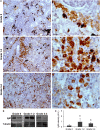


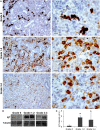

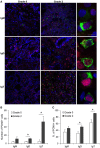

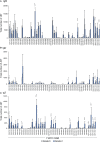
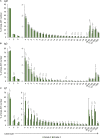
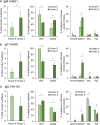
Similar articles
-
Back From the Brink: Alterations in B and T Cell Responses Modulate Recovery of Rainbow Trout From Chronic Immunopathological Tetracapsuloides bryosalmonae Infection.Front Immunol. 2020 Jun 3;11:1093. doi: 10.3389/fimmu.2020.01093. eCollection 2020. Front Immunol. 2020. PMID: 32582181 Free PMC article.
-
A portrait of the immune response to proliferative kidney disease (PKD) in rainbow trout.Parasite Immunol. 2020 Aug;42(8):e12730. doi: 10.1111/pim.12730. Epub 2020 May 31. Parasite Immunol. 2020. PMID: 32403171 Free PMC article. Review.
-
Exploring the immune response, tolerance and resistance in proliferative kidney disease of salmonids.Dev Comp Immunol. 2019 Jan;90:165-175. doi: 10.1016/j.dci.2018.09.015. Epub 2018 Sep 22. Dev Comp Immunol. 2019. PMID: 30248359
-
What goes around comes around: an investigation of resistance to proliferative kidney disease in rainbow trout Oncorhynchus mykiss (Walbaum) following experimental re-exposure.J Fish Dis. 2017 Nov;40(11):1599-1612. doi: 10.1111/jfd.12628. Epub 2017 Apr 21. J Fish Dis. 2017. PMID: 28429822
-
Immune responses of fish to Ichthyophthirius multifiliis (Ich): A model for understanding immunity against protozoan parasites.Dev Comp Immunol. 2019 Apr;93:93-102. doi: 10.1016/j.dci.2019.01.002. Epub 2019 Jan 7. Dev Comp Immunol. 2019. PMID: 30630003 Review.
Cited by
-
Back From the Brink: Alterations in B and T Cell Responses Modulate Recovery of Rainbow Trout From Chronic Immunopathological Tetracapsuloides bryosalmonae Infection.Front Immunol. 2020 Jun 3;11:1093. doi: 10.3389/fimmu.2020.01093. eCollection 2020. Front Immunol. 2020. PMID: 32582181 Free PMC article.
-
Passive Immunization Delays Disease Outcome in Gilthead Sea Bream Infected With Enteromyxum leei (Myxozoa), Despite the Moderate Changes in IgM and IgT Repertoire.Front Immunol. 2020 Sep 11;11:581361. doi: 10.3389/fimmu.2020.581361. eCollection 2020. Front Immunol. 2020. PMID: 33013935 Free PMC article.
-
Functional and Phenotypic Characterization of B Cells in the Teleost Adipose Tissue.Front Immunol. 2022 May 10;13:868551. doi: 10.3389/fimmu.2022.868551. eCollection 2022. Front Immunol. 2022. PMID: 35619704 Free PMC article.
-
Rainbow Trout IgM+ B Cells Preferentially Respond to Thymus-Independent Antigens but Are Activated by CD40L.Front Immunol. 2019 Dec 17;10:2902. doi: 10.3389/fimmu.2019.02902. eCollection 2019. Front Immunol. 2019. PMID: 31921163 Free PMC article.
-
Protective Immunization of Atlantic Salmon (Salmo salar L.) against Salmon Lice (Lepeophtheirus salmonis) Infestation.Vaccines (Basel). 2021 Dec 23;10(1):16. doi: 10.3390/vaccines10010016. Vaccines (Basel). 2021. PMID: 35062677 Free PMC article.
References
-
- Hedrick RP, Macconnell E, De Kinkelin P. Proliferative kidney disease of salmonid fish. Annu Rev Fish Dis (1993) 3:277–90.10.1016/0959-8030(93)90039-E - DOI
Publication types
MeSH terms
Substances
Grants and funding
LinkOut - more resources
Full Text Sources
Other Literature Sources

